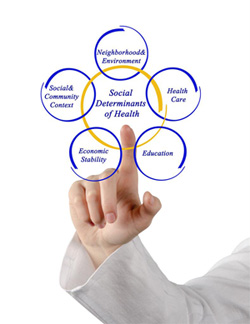Web Exclusive5 Ways to Resolve Latino Health Care Inequities Leveraging Social Determinants of Health Data to Address Latino Health Care Disparities 
As a Latina, an immigrant, and a single mom who had to find her way in a new country, I stand side by side with my beloved Hispanic community that opened its heart to me and many others with candor and exuberance. Hispanics make up more than 50% of the demographics of the Bronx in New York. Its demographic transformation began with the migration of the Puerto Rican community in the 1940s and when other non-Hispanic ethnicities left the county—subsequently making the Bronx predominantly Latino. Today, this community has diversified, shifting from predominantly Puerto Rican to mainly Dominicans. With more than 20 years in the health care industry, I have been saddened by the county’s chronic poverty and a lack of access to social support, forcing a community to endure distress and a scarcity of basic needs. Why is it still one of the poorest congressional districts although it is surrounded by such wealth? It is time to build off this community’s resilience to ensure that its residents get equal and fair access to quality food, permanent shelter, and other social resources. It is no secret that health care inequities exist in the United States. This is defined simply as differences in health care that are linked to racial, ethnic, gender, age, social, demographic, or economic disadvantages. These disparities in health care harm individuals and communities, as well as the nation as a whole. Ethnic and racial health disproportions not only weaken communities but also the entire health care system. Statistically, adult Latinos are more likely to suffer from asthma, diabetes, liver disease, cancer, and other health conditions than their non-Latino counterparts. In fact, a recent survey shows that the biggest health issues and concerns for Latinos were diabetes and cancer. For Latino children, the risk for infant mortality, as well as the likelihood of suffering from asthma, obesity, diabetes, and depression are considerably higher. While health care spending totals more than $2.5 trillion annually and continues to increase every year, racial minorities, as well as additional at-risk populations, suffer disproportionately from worse health outcomes. Common inequities result from disparities in access to health insurance, health care, and more, leaving these groups to face increased health care costs, more work absences due to illness, and decreased income. While the US health care system is among the best in the world, it is not always accessible or affordable. Medical personnel shortages, language barriers, medication costs, and a lack of health literacy intensify the inequities and makes managing chronic illnesses more of a challenge. These disparities negatively impact communities and the country, but by leveraging social determinants of health, Latino health care inequities can be resolved. Provide Easy Access to Comprehensive Quality Medical Care Increasing the number of multispecialty practices can help chronically ill community members gain faster and easier access to crucial care. Creating ease of access that requires little in the way of travel expenses means comprehensive quality medical care—primary and specialty care—in neighborhoods and communities. Address More Than Just Health Care Health care providers can also address other needs, such as helping coordinate care, aiding in workforce development, and guiding Women, Infants, and Children and SNAP enrollment. Represent Communities With a Diverse, Bilingual Workforce To better represent communities with a diverse, bilingual workforce, societies should work to empower minority students by providing them with the information, resources, and opportunities to seek and attain health-focused careers. Provide an Informed, Aware Workforce Partner With Local Elected Officials to Promote Health Awareness Ultimately, elevating Latinos’ worth and bridging these health care equity gaps will fuel the desire of a community that wants to be healthy and live comfortably. It will also empower it to advocate for a brighter future. — Silvia Posada is senior vice president of network development for Essen Health Care, one of the largest private comprehensive multispecialty medical groups in the Bronx.
Resources Latino health inequities compared to non-Hispanic whites. Families USA website. https://www.familiesusa.org/resources/latino-health-inequities-compared-to-non-hispanic-whites. Published September 25, 2018. |

